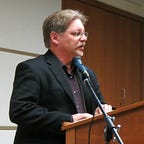Burning ‘Slaughterhouse-Five’
On November 10, 1973, school officials in Drake, North Dakota, burned copies of Kurt Vonnegut’s novel Slaughterhouse-Five.
If you haven’t read the novel — and you should — it is the story of Billy Pilgrim, an American soldier who survives the bombing of Dresden. On February 13, 1945, allied aircraft dropped 4,500 tons of high-explosive and incendiary “firebombs” that devastated an area of around 13 square miles of that city.
Vonnegut enlisted in January 1943, three months after his mother’s suicide. He was captured by the Germans and held as a prisoner in Dresden. He and some of his fellow POWs survived because they had been herded into an underground slaughterhouse meat locker called “Schlachthof-Funf.” Vonnegut called Dresden “possibly the world’s most beautiful city” and writing 20 years after the event he did not even try to describe the bombing because it was so horrific.
After the war, he went to graduate school (anthropology) worked as a publicist at General Electric, got married and had three kids and adopted three more, and tried writing novels. Kurt Vonnegut wasn’t a well-known novelist but he had published five novels before Slaughterhouse-Five. He had received some recognition for two sci-fi satires, Sirens of Titan and Cat’s Cradle, but it was Slaughterhouse-Five that made him an internationally-known writer.
The novel was a best-seller and received critical acclaim and eventually began to be taught in colleges and some high schools. It has also been banned many times, for being obscene, violent, and for what is sometimes seen as an unpatriotic description of the war.
In the North Dakota case, a young high school English teacher assigned Slaughterhouse-Five to his students. Most of them later said that they liked the book and some thought it was the best book they had read in school. When they were still reading and discussing the novel, one student complained to her mother about the obscene language. The parent went to the principal, who took the complaint up the chain of command. The school board voted that it should be not only confiscated from the students but also burned.
Some students didn’t want to give up their books, but officials searched lockers and confiscated all copies. A custodian at Drake’s combination elementary and high school put 32 paperback copies of Slaughterhouse-Five in the furnace beneath the school gym.
The school board also reviewed the English department’s reading list and decided to burn Deliverance by James Dickey and a short-story anthology.
Vonnegut wrote a letter to one of the members of the Drake school board:
(excerpt)
Dear Mr. McCarthy:
I am writing to you in your capacity as chairman of the Drake School Board. I am among those American writers whose books have been destroyed in the now famous furnace of your school. […]
If you were to bother to read my books, to behave as educated persons would, you would learn that they are not sexy, and do not argue in favor of wildness of any kind. They beg that people be kinder and more responsible than they often are. It is true that some of the characters speak coarsely. That is because people speak coarsely in real life. […]
If you and your board are now determined to show that you in fact have wisdom and maturity when you exercise your powers over the education of your young, then you should acknowledge that it was a rotten lesson you taught young people in a free society when you denounced and then burned books — books you hadn’t even read. You should also resolve to expose your children to all sorts of opinions and information, in order that they will be better equipped to make decisions and to survive.
Again: you have insulted me, and I am a good citizen, and I am very real.
I do recommend the novel. If you’re not a reader, there is a film version from 1972 directed by George Roy Hill. I wonder if any school board members had seen the film. I suspect they did not read the novel. And none of us can judge a novel by a film adaptation.
The film version of Slaughterhouse 5 does make clear the non-linear structure of the novel and the mixing in of science-fiction elements with the autobiographical WWII scenes. Billy Pilgrim lives segments of his life for a few minutes and sometimes gets unstuck in time and jumps years or decades into the past or future. Those jumps are not uncommon in films and in modern novels. Billy is a POW, then back to his work as an optometrist, then he is a plane crash survivor and then he’s a new father and even a UFO abductee. Vonnegut’s sci-fi is a big part of the novel as Billy is abducted by a race of fourth-dimensional beings called Tralfamadorians, who select him as an Earth specimen in their menagerie of lifeforms from across the universe.
But this is not a book review. This is the cautionary tale of censorship. A figurative firestorm hit Drake via the media in 1973. This little town of 650 people is still infamous for having burned those copies of what is more often considered to be a classic. The bannings of the novel continue.
